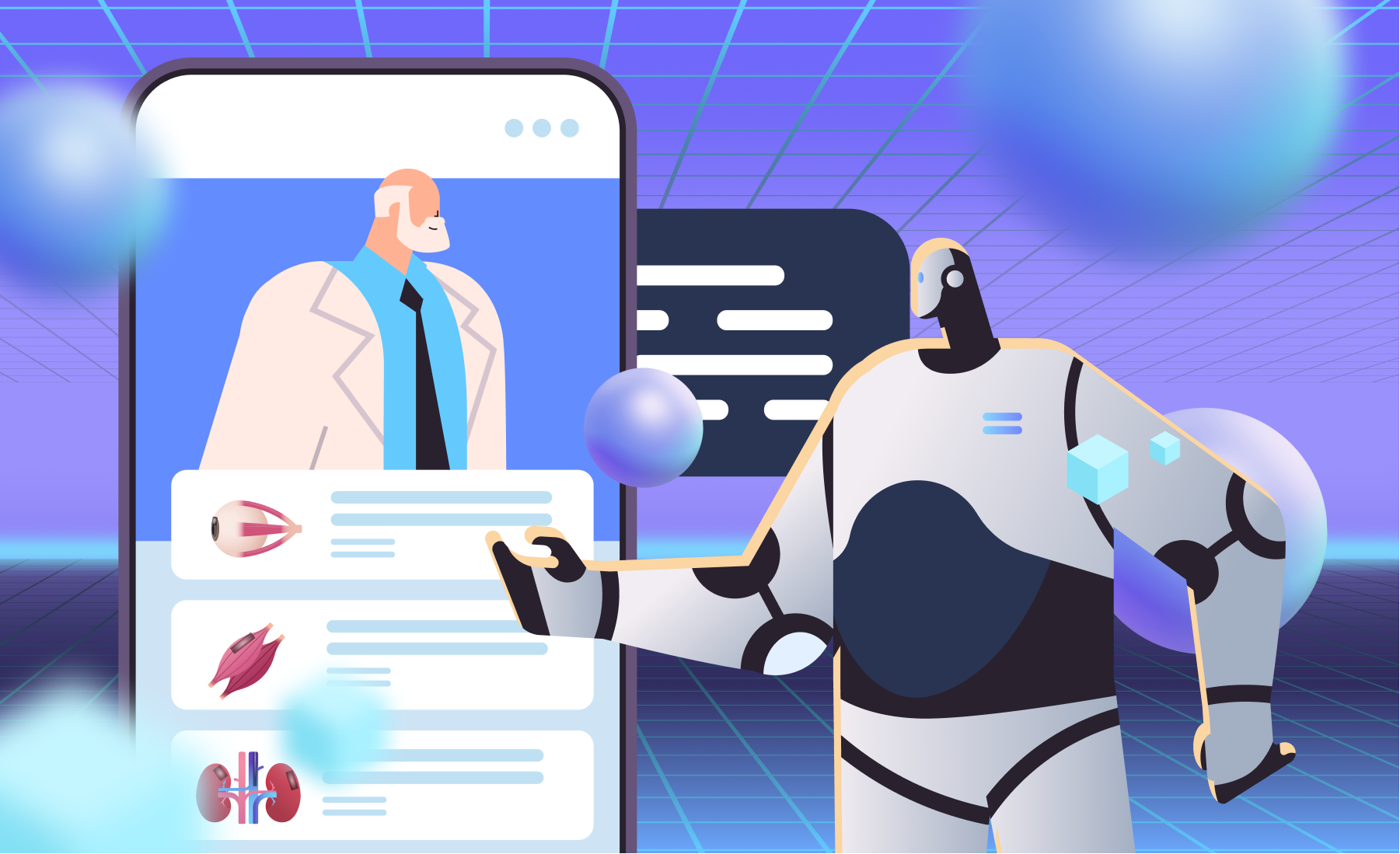How can AI integrations improve the management of electronic health records?
The business has to deal with huge amounts of data every day. Processing them manually is a complicated task, luckily, now it can be automated with the help of AI. By integrating AI-aided technologies into the workflow of the company, the entrepreneur can make the data processing clear, avoid human errors, make data-driven decisions, and increase customer loyalty.
In this article, we are explaining how backend AI integrations help establish clear data processing in the healthcare industry and how this technology improves the work of electronic health records. We hope you’ll also find some hints on how to integrate AI-powered technologies into your business.
Why is it hard to manage patient records without healthcare AI integration?
Electronic health records are a digital substitute for patients’ paper charts. Electronic health records, or EHRs, display detailed information about the patient: age, gender, ethnicity, health history, medicines, allergies, immunization status, lab test results, and hospital discharge instructions as well as billing information.
Their greatest advantage is that EHRs go beyond a single medical organization. The information displayed in them can be accessed by several entities: laboratories, ambulances, insurers, and patients themselves. By using EHR, medical teams can access the latest information about patient’s health and provide more patient-centric help. Here are a few situations, when EHRs can be useful:
- The team of paramedics can find out about patients’ allergies and adjust the treatment if the patient is unconscious
- Patients can access the lab results and see the health stats, which can encourage them to take their medication and maintain a healthy lifestyle
- The lab results run last month or week are already in the record, so the doctor doesn’t need to run duplicate tests to see how the result changes
- If the patient decides to move to another city or state, there is no need to print the EHR, as it can be accessed by multiple organizations
Nowadays the EHR systems in large medical networks are thought to be rigid and hard to set up because they are usually built around older underlying technologies, which affects their effectiveness.
To add, some EHRs have a huge amount of data that might be hard to analyze and sort when the sick person needs to receive treatment on the spot. Backend AI integration in healthcare is a solution that can make EHRs both more flexible and easier to analyze. Let’s find out how modern medicine can benefit from AI integration.
How modern medicine benefits from healthcare backend AI integration?
According to surveys of Statista, in 2021, the global market of AI in healthcare was worth over $11 million worldwide. More than that, the polls show that about a fifth of all medical organizations are in the process of integrating AI into their workflow. The most common type of healthcare AI integration is natural language processing. Natural language processing, or NLP, is a machine learning technology that gives computers the ability to recognize, process oral and text forms of human speech, and generate responses.
Medical organizations store huge amounts of data like images, notes, graphs, and tables. The AI helps to analyze this data and find patterns that are not visible to human eyes. It makes healthcare AI integrations useful in the following cases:
Drug discovery
AI is used for finding new drugs, repurposing them, and estimating their possible impact on disease treatment. The technology can analyze huge databases of molecules, protein structures, and measurement records to understand how they can bind with each other. This process helps find potential drug candidates and estimate their safety, greatly reducing the drug development price.
Atomwise is a startup that implements healthcare AI integration to discover new drugs. In 2015, during the Ebola outbreak, Atomwise cooperated with IBM to find the protein that could prevent the Ebola virus from getting into live cells. The deep learning mechanisms managed to complete the research within a day, while without the technology the analysis may take years.
Assistance during the emergencies
In case the patient has a cardiac arrest, immediate help is crucial for survival. To deliver help as soon as possible, the ambulance dispatchers need to understand the patient’s problem the moment they call. Human dispatchers manage to identify cardiac arrest cases 73% accurately but speech recognition mechanisms do it even more accurately.
Corti is a tool that implements healthcare backend AI integration that trains itself by analyzing dozens of phone calls. It learns to analyze verbal and nonverbal clues like background noises, the patient’s voice, and other signals that may serve as a symptom of cardiac arrest. The sooner such a crisis is identified, the more quickly the patient will get the needed treatment.
Surgery
The robots with healthcare AI integration analyze the pre-operation records and guide the instrument of the surgeon during the operation. The robots are already used for heart, orthopedic, and eye operations. It was estimated that patients who were operated on with the help of robots have up to 5 times fewer complications than ones treated by man only.
By the way, our team can integrate AI into your fintech, real estate, booking, or healthcare app. We can enhance an already existing software with backend AI integration, or build the app with this technology from scratch.
How do healthcare AI integrations make electronic health records more flexible?
The study conducted by the American medical association in 2017 showed that the average physician spends about 6 hours managing EHRs daily. This factor becomes a great reason for burnout and forces doctors to spend 1,5 additional hours in front of their computers after their workday is completed.
Many believe that integration of AI into healthcare can make the work with EHR less time-consuming. Let’s have a look at how this technology helps doctors focus on treatment rather than computer work.
Imaging analysis
AI mechanisms help clinicians analyze imaging information like radiographic and tomographic images. They read the images, compare them to other scans in the database, and help find interconnections invisible to human eyes. This procedure helps to avoid human mistakes in reading images from EHRs and establish more precise diagnoses.
To make the imaging analysis easier, IBM released the tool called Watson Imaging Patient Synopsis. This AI-aided tool analyzes the information collected in EHR and gives radiologists information about patients’ medical history. Thus, with the help of healthcare AI integrations, radiology specialists and cardiologists can estimate the x-ray relying on medical history and establish more precise diagnoses.
Diagnosis prediction
Modern NLP and ML mechanisms can read the entire medical history of the patient, connect all the facts, and predict the possibility of severe diseases like diabetes, pneumonia, or even cancer. The AI can extract information from unstructured notes and predict possible crises before they get acute.
For instance, the Department of Veterans Affairs and DeepMind Health managed to create an AI-aided tool that can predict acute kidney injuries 48 hours before they come, which can save the patient’s life.
Documentation management
Medical workers spend a lot of time managing documentation: they need to only type all the information but also keep them up to medical standards. Nowadays healthcare backend AI integrations help doctors form documentation from unstructured notes, analysis, and claims.
Nuance is the company that has invented an NLP-based solution that can recognize the voice of the doctor and transfer it into written notes. After the conversation is completed, it is formed into comprehensive medical notes that adhere to documentation standards.
Personalized treatment
The healthcare AI integrations allow medical teams to elaborate more personalized treatment strategies. In the past, these strategies were generic and rule-based but now AI can analyze the information in EHR and come up with an individual treatment plan. The plan still needs to be approved by a doctor based on their knowledge and experience but at the same time, AI serves as a data-based second opinion.
Challenges related to the use of healthcare AI integrations
Although healthcare AI integrations ease up the work of physicians, they might bring some risks and limitations when used for managing the global healthcare system.
High chance of inaccuracy
The usage of healthcare backend AI integrations heavily relies on data. The databases of some organizations might not be big enough to cover all possible illnesses and conditions. There might not be enough data about certain populations, illnesses, or environmental features, which can result in a medical error. That’s why final decisions about treatments can only be taken by humans, while AI can only serve as a tool. As health organizations will keep integrating AI into their workflow, the databases will grow and learn to give more accurate predictions and diagnoses.
Overlooking social inequality
When making diagnoses, AI-integrated healthcare systems may prescribe the treatment in a certain medical organization and with certain medications. If the treatment is costly, the patient from a low-income neighborhood might not be able to afford it. This situation can be improved by human doctors who can adjust the treatment to the needs and preferences of a certain patient.
Data storage
Machine learning algorithms need to be trained with patient data. According to recent studies, about 93% of hackers can breach the security of an organization and get access to private information. In these circumstances, it’s quite risky to store the private info of the patients and use it to train AI. Huge systems like Amazon have stronger security systems compared to small and middle-sized clinics that might lack technical support. However, when AI will start to be used globally, new methods of data protection will emerge. For example, databases might soon be protected with blockchain technology.
Unemployment
According to a recent report from the World Economic Forum, AI is predicted to replace about 85 million jobs by 2025. Although AI won’t replace human doctors who take part in the treatment process, it might become a substitute for some members involved in hospital management. For instance, assistants who help doctors manage patient medical history are at risk of being replaced by speech recognition mechanisms, while hospital managers responsible for managing the appointment schedule can be replaced by bots. At the same time, someone will need to manage the AI systems and implement new tools, that’s why some new positions will appear as well.
Although healthcare backend AI integrations bring many risks nowadays but in the future, they will keep improving. The databases will keep growing and there will be more information to train AI algorithms. To add, data might soon be protected by blockchain technology, which will solve the problem of patient privacy.
Wrapping up
Integrating AI in healthcare is a great chance to make data-driven decisions as well as find patterns and tendencies invisible to human eyes. By integrating AI into the backend of electronic health records, we can reduce the load on the medical staff, help manage documentation, elaborate personalized treatment plans, or predict dangerous diseases like cancer and kidney injuries before the crisis comes.
How can I get an AI integration for my startup?
AI integrations can be effectively used not only in the field of healthcare but also for scaling and promoting businesses in the fields of real estate, FinTech, booking, and others. If you want to install AI into your software, don’t hesitate to get in touch. We can scale the design of your app and develop AI-aided features.

